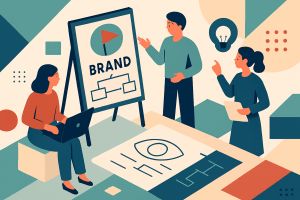
How AI is Transforming Marketing: Strategies for Creative Leaders
Revolutionize Your Marketing with AI
Discover practical strategies for integrating AI and automation into your workflows.
Understanding AI in Marketing
AI in marketing fundamentally shifts how brands interact with consumers. It enables unprecedented levels of personalization, efficiency, and engagement in marketing strategies. By leveraging data analytics, machine learning, and automation workflows, creative leaders can make informed decisions that enhance branding and customer relationships.
The integration of AI automates repetitive tasks, freeing up time for marketers to focus on creative leadership. For example, generating tailored content, optimizing ad placements, and analyzing consumer behavior can all be enhanced through AI technologies. This data-driven approach allows marketers to understand their audience with greater clarity.
Current Trends in AI Marketing
Several trends illustrate how companies utilize AI in their marketing strategies. Chatbots, for instance, improve customer service by providing instant support and personalized engagement. Companies like Sephora have implemented chatbots to assist customers, driving up engagement and satisfaction.
Another trend is predictive analytics, which utilizes AI to forecast consumer behavior and trends. Netflix exemplifies this by using AI algorithms to recommend shows based on viewing habits, significantly enhancing user experience and retention rates. These trends indicate that businesses leveraging AI can gain a competitive edge.
Practical AI Implementation
Implementing AI in your marketing strategy may seem daunting, but it can be broken down into manageable steps. Start by identifying specific areas where automation workflows can enhance efficiency. This may include email marketing, social media management, or customer support.
Next, invest in the right AI tools designed to meet your needs. Tools like HubSpot, Drift, or Salesforce Einstein can help automate tasks and provide insights into customer behavior. Once you’ve selected the tools, develop a strategy for integration, ensuring your team is trained and aligned on these new systems.
Step-by-Step Implementation Guide
- Assess your current workflows and identify automation opportunities.
- Research and select AI tools that fit your marketing needs.
- Train your team on how to utilize these new tools.
- Set measurable goals for your AI integration.
- Monitor progress and adjust your strategy based on performance data.
Framework for Success
To ensure effective implementation of AI in marketing, utilize this checklist. This framework will help you assess your readiness and guide the integration process. Consider your tech stack, the skills of your team, and the scalability of the tools you choose.
- Is your data clean and organized for AI tools to process?
- Do your team members understand the benefits and functionalities of the AI tools?
- Have you set clear KPIs to evaluate the success of your AI initiatives?
- Are you prepared for the initial investment in time and resources?
Examples of Successful AI Integration
One notable example is Coca-Cola, which uses AI to drive its marketing strategies. By analyzing consumer preferences through social media and purchasing patterns, they personalize campaigns that resonate with their audience, driving results through targeted advertising.
An anonymized case study involves a small e-commerce business that utilized AI-driven email marketing campaigns. By segmenting their audience based on purchasing behavior and preferences, they reported a 30% increase in engagement and a 20% uplift in sales within the first month of implementation.
Measuring Success
Defining KPIs is crucial for evaluating the success of AI in marketing. Metrics such as customer engagement rates, conversion rates, and return on investment (ROI) from campaigns using AI should be monitored regularly. Monitoring these KPIs will provide insights into how well your AI integration aligns with your overall marketing goals.
Common pitfalls include lack of clarity in objectives, insufficient training for staff, and not having a flexible approach to adjusting strategies. Ensure that your team is prepared and that you’re open to iterating on your strategies as you gather data and feedback from campaigns.
Common Misconceptions About AI in Marketing
A prevalent misconception is that AI can completely replace human creativity and intuition. While AI is a powerful tool that can enhance efficiency and provide insights based on data, it lacks the emotional intelligence and nuanced understanding that human marketers possess. Successful marketing still requires a blend of creativity, emotional connection, and strategic thinking.
AI should be viewed as a partner that enhances human capabilities rather than a replacement. The most effective marketing strategies will always be those that combine data-driven insights with creative storytelling and authentic brand messaging.
Next Steps for AI in Marketing
Ready to transform your marketing strategy with AI? Start by identifying the specific areas where automation can add value. Research suitable tools, and take the first step in implementing a small-scale AI initiative this week. Remember to involve your team to foster a culture of innovation and experimentation.
By embracing AI, you’re not just enhancing efficiency; you’re positioning your brand for long-term success in an increasingly competitive landscape. Schedule a consultation to explore tailored strategies for your unique marketing challenges and unlock the potential of AI for your brand.


